GRANADA - ALHAMBRA
On a timeline to the Alhambra
Gine read a while ago, that people travel to Spain to visit the Alhambra and that they only let 8000 people a day in, with 400 every half hour and that tickets are often sold out 6 month in advance,so she booked tickets. You have to bring your passport and show up on time. When checking two days ago: there were only a few tickets left for 08.30. Good thing we have our tickets. Our entrance is at 10.30 – we want to be there early and guess to walk 20 Min (+finding the way): so let’s leave at 9.30:
Why is the Alhambra sold out?
- Like many others we came to Granada to visit the Alhambra: one of the most important architectures of the Islamic world and one of the most visited sites in Spain
- It is the great Moorish Palace: the fort and palace were first built in 899 AD – then it got renovated by the Moorish kings in the 11th century. In the 14th Century, Yusuf I Sultan of Granada converted it into the Royal Palace
- For the Spanish it is also the last stronghold of retreat
- When it got built the rest of Europe was still in the dark ages
- Water was rare and precious in most of the Islamic world: it was the purest symbol of life for the Moors. Here in the Alhambra a lot is decorated with water (today we had too much water coming down from the sky)
- At one time the Alhambra was a town (medina) we could still see some of the ruins of the medina (it got destroyed by the french in 1812)
Walking up to the Alhambra:
One of the ways to go to the Alhambra is to walk up and very convenient we live on the road up: we can already see the Puerto de las Granadas from our room window, which is the start on the way up: we walked up the beautiful tree lined road passed by the Puerte de Biberrambia and then entered the Alhambra via the Puerta de los Carros: barely inside we did discover there are a lot of people, also there are a lot of “guards” here to help you find the way.
we didn’t had the time for the Alcazaba or the old Fort (red castle) – and on our way back it was raining so much, that we didn’t think it is necessary to visit.
King Charles V castle
This renaissance palace got built by a pupil of Michelangelo: it has a huge circle courtyard: it more feels like a huge arena. Later when we came back Gine did a walk around the top to really admire the nice round building – but seriously you don’t think it is a palace: as you don’t see a room or anything and all you see is the courtyard no flowers or fountains – so I honestly think you should be able to get a bit a nicer place as a king.
Who is king Carlos / Charles V?
- the Holy Roman Empire had seven rulers and yes they were all named Charles
- Charles I or Charles the great was the founder
- Charles V: is known as his territory stretched most of Europe (except England, France and Russia) as well the Spanish colonies in the new world of Americas. When he was 56, he voluntarily gave up his vast realm and retired and spend the last year of his life in a Spanish monastery
- He was the son of Philip of Habsburg, born in the Netherlands, his grandfather was the Archduke of Austria and the holy empire – and his mother was the daughter of King Ferdinand and Queen Isabel of Spain: by birth he became King of Spain, he also became King of Sicily and Naples, he was then elected as the Holy Roman Emperor
- He had to fight against the France and the Muslims coming in from Turkey, oversees his armies conquered Mexico and Peru: from there they brought the gold back
- He married Isabella the daughter of the Portuguese king and later became also King of Portugal, his sister had to marry the king of Hungary – he wanted his son to marry the English queen Mary I: but the British refused to crown a catholic king
- He respected the Moorish palace and built a new palace for the official functions and used the existing Palacios Nasrid as a royal residence
Who are the Nasrid’s?
- The Nasrid Dynasty was the last Muslim dynasty on the Iberian Peninsula: they ruled the Emirate of Granada from 1230-1492
- 23 emirs or Sultans: a sultan (it comes from the Arabic word power, means sovereign leader who isn’t under anyones authority as where the emir controls some land and has some killers on the payroll but isn’t necessarily sovereign)
- When you see colors, they are as it is suggested by the Quran: red for blood, blue for heaven, green for oasis and gold for wealth
- When you look up and you can see stalactite ceilings: it is the theme of the water
- you can see everywhere Arab script: Muslims avoided to make images of living creatures which was God’s work, but they carved decorative religious messages: one of the phrases “only allah is victorious” is repeated 9000 times in the palace (a cursice W with a nose on the left and a vertical line to the right)
Nasrid Palace
Soon we stand in the line up for the Nasrid Palace – yes there is a line up even you have tickets. once 10.30 hit, we are lucky and fairly one of the first once to enter: Overall the palace was amazing – the Moorish/Islamic architecture, stucco, it was amazing. Gine said to Paul she feels like being in a palace where the story of the fairytale of the 1001 nights took place and the sultan relaxed – and guess what: Paul didn’t know the story.
what did we actually see in the palace:
- Mexuar – Administrative office: our first spot we entered, this was the council of the wise men, there is also a prayer room with a niche (or Mihrab) facing Mecca – already we are stunned with the stucco of the walls and the typical Muslim doorways: by the way every spot is carved out. After crossing a little courtyard with a pond we entered:
- Patio de los Arrayanes : Moors loved patios with garden and water. This one was where the Sultans women looked down – on both sides were apartments for the wives (a sultan could have a maximum of four!! – but then there was also a dorm for the concubines (because he could have as many as he wanted). As the Moorish believed that women shouldn’t go out, so they were stuck here. I mean it is a beautiful courtyard – but to be only here.
- Gran Salon de los Embajadroes or Throne room of the Grand hall or Salon de Comares: this is an amazing room, especially when you look up and around you can only look and look: maybe start to count on how many times you can read the Allah is victorious or the ceiling of with 8017 inlaid pieces (so you can imagine the complexity of Allah’s universe). Besides that, there is some cool history which happened in this room: Here the Sultan was seated on the throne, here the last Moorish king Boabdil signed the terms of his surrender, and here Columbus asked Isabel and Ferdinand to finance his sea voyage to the orient (as where Ferdinand and his professor laughed and called him mad Isabel said ‘si senor’)
- Patio de ls Leones: this is one cool courtyard with all the columns it looks stunning ok let’s not forget the super cool entry with yes carved stucco super cool Moorish arches, but when you know a bit more it is even more fascinating: the name is easy there is a fountain with 12 marble lions: you can see four channels living carrying water to tiny fountains (we had to be careful to not step on one): it symbolises to go to the corners of the earth (yes it was still believed that the earth is flat), the 124 columns can even flex during a earthquake, and the around here were the private apartments (even we never really saw the bedroom of the sultan)
- Sala de los Reyes – Hall of the kings: yes we are amazed at the super cool stucco, but what is super unique in this section there are two massive paintings on the ceiling (by the way Gine read they are painted on goat leather). The first one we saw shows scenes of the Sultan and his family: as per Paul it is not a very loving family as one get’s a spear into the heart, a lady claps their hand looking as another one getting killed (guess life was different) and the other painting shows 10 of the 23 Sultans of the Alhambra: makes you wonder on how they knew on how they looked like or if the painting was done over a long period of time as this spans several generations. In the center room we could see that funky stalactite ceiling: which looks kind of cool as it looks they a dripping ceiling.
- Sala de los Abencerrajes: the Sultan’s living room: ok as there is no furniture you wouldn’t know, but the room is again another mind blower: when you look up at the ceiling you can see a gigantic star – the 8-sided islamic star (it is the seal of the prophets or Rub el Hizb: like 2 overlapping squares) and in the middle yes there is a little pool. Gine had to tell Paul the story which happened here: one of the sultans took a new wife and wanted to disinherit the children of his first wife, so he killed them (except one Boabdil) and kept the 36 heads of the Abencerraje family in the pool in this room.
- Sala de las Dos Hermanas – Hall of the two sisters: and yes you can still top it: when looking up at this ceiling: wow a gigantic star with the stalacties, stained glass windows and then all along the walls more mind-blowing stucco, openings, Moorish doorways: no wonder it was used as another reception hall. They say if you look at the patterns you can see some Moorish math (I couldn’t figure it out, there is too much to see). From there it goes out into a little sitting area: tiles at the bottom: huge windows to all three sites (we learned that the windows went so low, as the people in that time sat on the floor – and here we still saw also some of the colors on the stucco – lots of blue for the heaven. In one room when looking up we saw a huge colorful stained glass window.
- Jardin de Landaraja: we already could see out from the top down into this beautiful little courtyard. Before we walked along a hallway where we had the perfect views on the Moorish part of Granada or the Albayzin on the other side on the hill
- Banos reales: after going down we came to this brick rooms which at one time were a bath – not a lot to see
We are now leaving the Nasrid Palace area – it was super incredible – clearly a highlight on our trip!!
El Partial & Jardin de San Fransisco
As we came out it started to rain – really!!! So we were standing with a view other people in the Partial Palace and looked at the cute little pond. I think it’s important to remember that the Alhambra had in its lifespan 7 different palaces and this was one of it, after the rain let a bit off, we walked the steps up toe walk through the Jardin the San Fransisco: this is a beautiful garden with fews on the city: once this part was also a Moorish palace – then it got converted into a monastery (by the way in that church was where Ferdinand and Isabel were original buried before being moved into the Royal chapel in 1521). Let’s not forget Paul found another little friend in the ruins: a little black kitty. As we slowly walk up the hill we are ready to leave the Alhambra walls:
Generalife
- It’s the summer palace and garden of the sultans and outside of the protected walls of the Alhambra: the “country” estate of the Nasrid kings
- It means “the garden of the lofty paradise’: it is the closest thing on earth to the Quran description of heaven – it got planted nearly 600 years ago
Let's explore the gardens (in the rain!!!):
- Patio de la Acequia: this was super cool: several long pools with fountains in between – super nice flower and on the end is the Sala Regaio: it looks super gorgeous – perfect for picture taking (even in the rain): there are several gigantic hedges along with cut out doorways from where you can overlook another beautiful garden – lots of nice benches to enjoy it (if it doesn’t pour down rain). I may should mention you can nearly get lost and around every corner are beautiful plants, little ponds and nice views: Paul said he would have threatened it if the Sultan said let’s go for a walk in the yard, as it is always a very long walk.
- Sala Regaio (Summer palace): we walked up some stairs through it and from each one you had some nice views and I had the feeling you go from one courtyard with ponds and plants to the next: good thing there are signs saying “continuacion de la visita” otherwise we would have been lost.
- Escalera de Agua to the upper palace: and one last time up: those stairs are funky: the railing has water running in it and in the middle is a little water going to mini fountains in the platforms: we had then a final view on the gardens before we entered again the Alhambra walls.
Inside or our – Rain or sun?????
This time we walked down between some ruined houses and lots of big shrubby plants with nicely cut our windows so we could peak through them to see some ponds, ruins, flowers, to the St Maria church and then we ended up again at the Charles V palace. Had a quick break – and no it didn’t stop raining, so in the cold rain we wandered back down through the beautiful green forested street to our place and took off our wet staff to get a bit warm and dry.
Let’s go for a coffee: as we didn’t want to walk forever and didn’t want to go in a Bar for a coffee after walking around the Plaza Nueva we decided to have coffee right across our Pension Alfin: that really perked us up. Back in the room for a relax time and see there the sun came out: jackets on and we went down to the plaza so we can watch people: and see there barely 5 minutes later comes one of those huge grey clouds with no blue in the sky… so we headed back… and only went out ones more for supper. As we were not so inclined to do a lot of walking on the slippery cobble stones in the cold rain after seeing so many beautiful things already. I may should mention that our room has such beautiful windows that we saw several people taking a photo of us or the windows we were not sure.
Tomorrow we will leave cold rainy Granada in search for warm sunny weather.
A relaxing Good Bye to Granada
We decided to sleep in a bit – have a nice breakfast in the café across the road, and then leave relaxed. At least today it was not raining, but still cool. The breakfast was super yummy only way too much!!! We got our car out of the garage and after packing leaving Granada was as easy as coming in. It’s a beautiful city only too cold!!

 Alhambra, Andalucía, Spain and Canary Islands
Alhambra, Andalucía, Spain and Canary Islands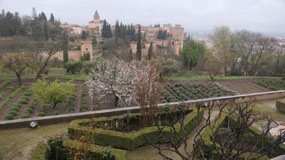
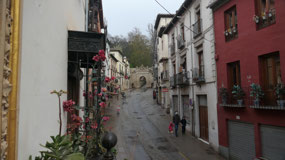
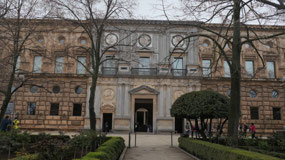
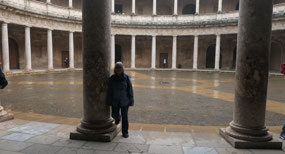
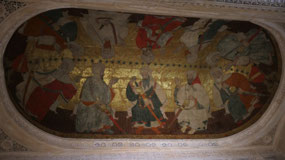
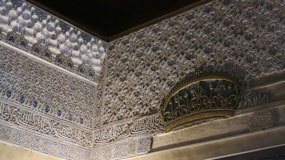
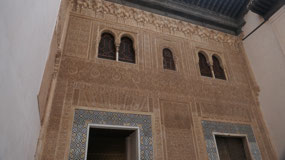
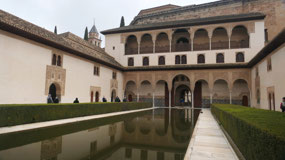
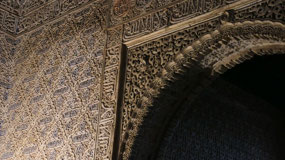
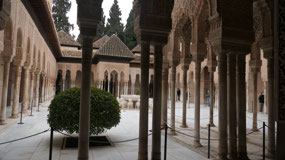
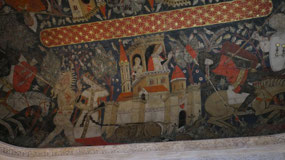
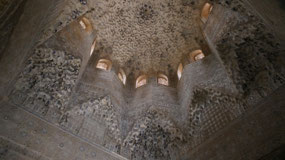
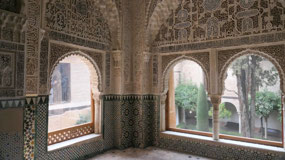
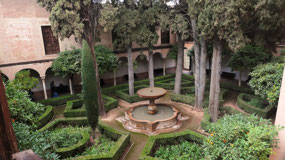
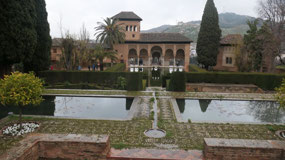
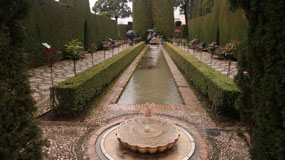
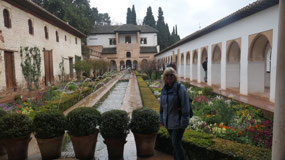
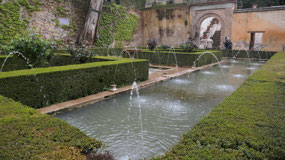
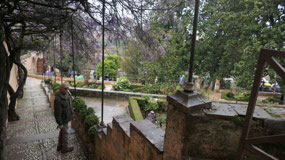
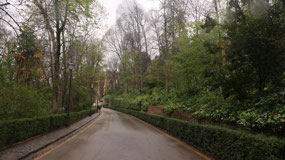





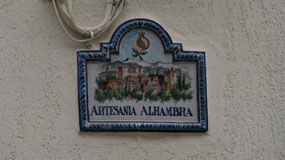
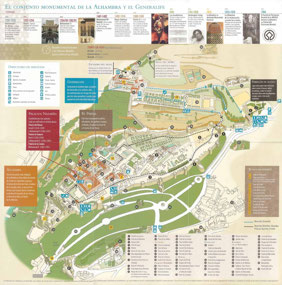
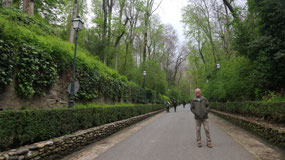

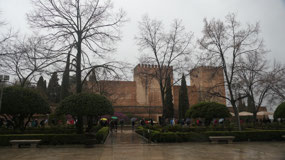
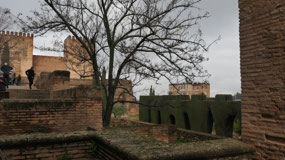
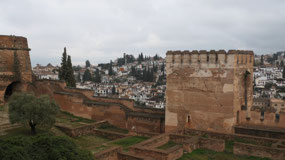
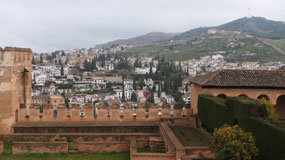
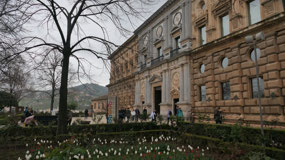
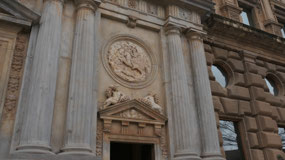
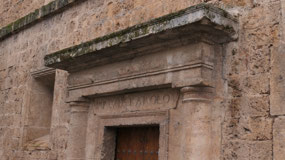
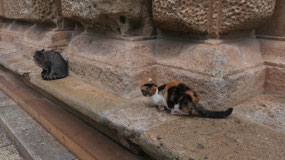

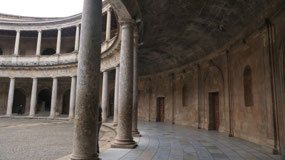
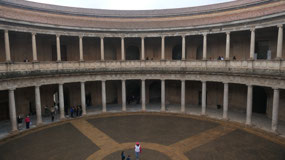
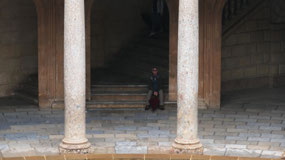
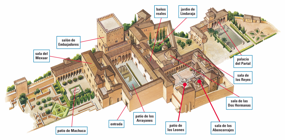
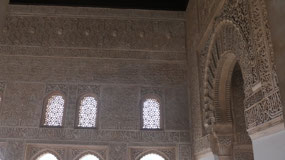
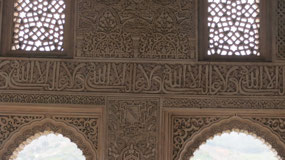
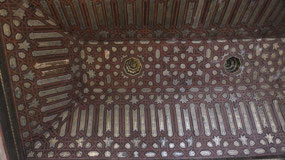
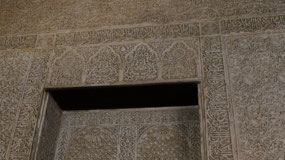
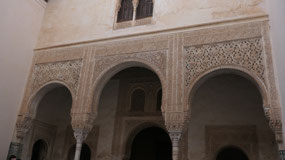
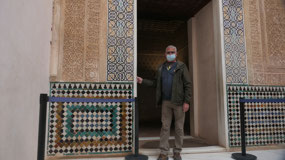
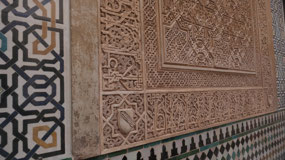
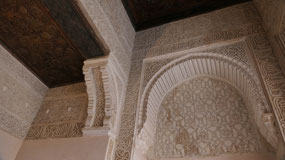
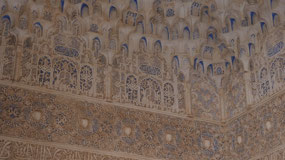
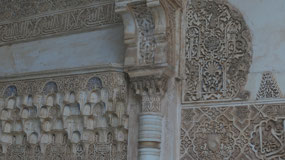
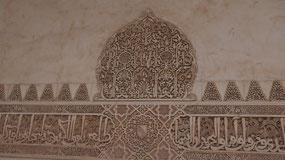
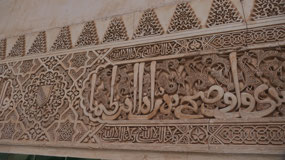
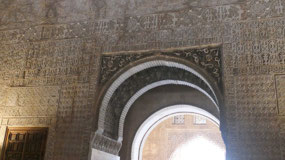
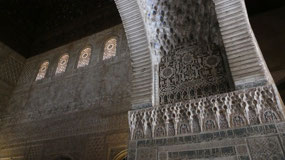
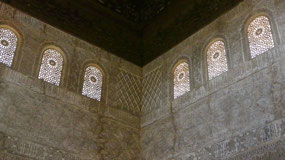
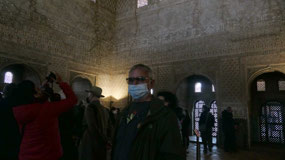
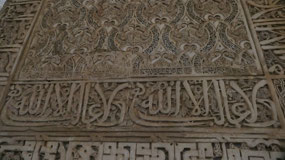
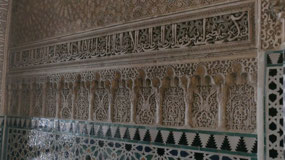
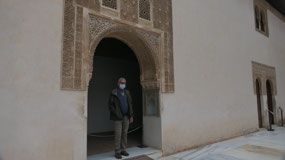
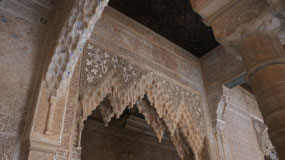
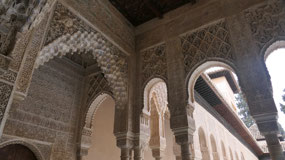
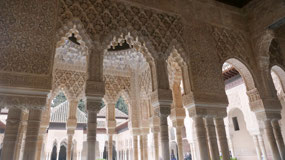
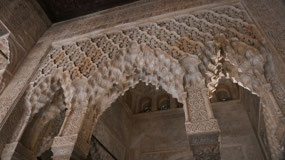
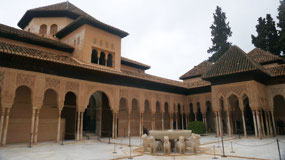
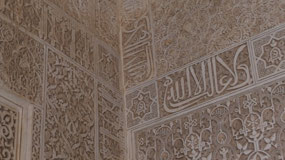

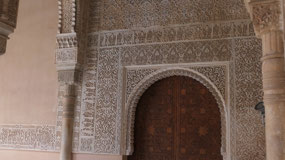
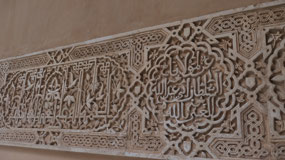

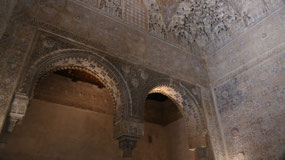

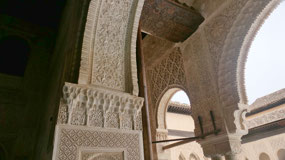
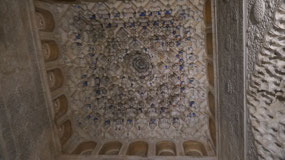
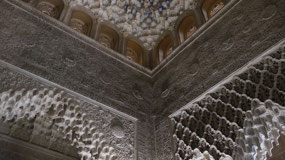
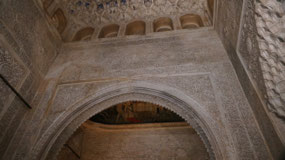
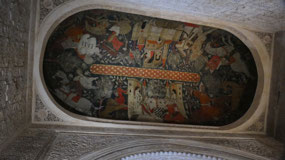
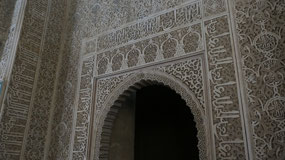
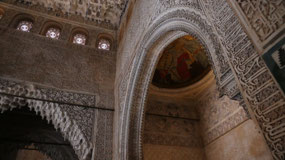
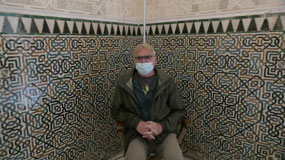
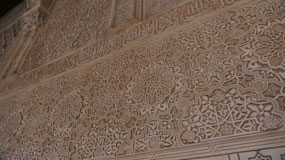
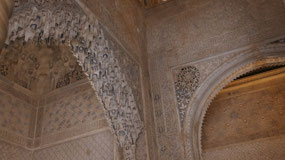
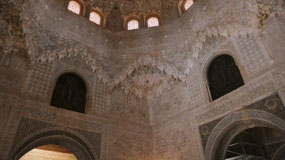
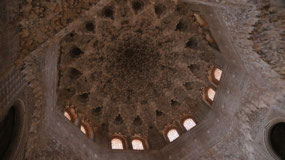
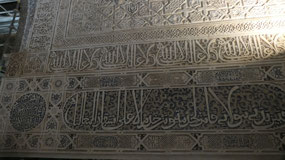

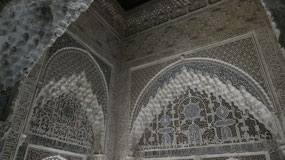
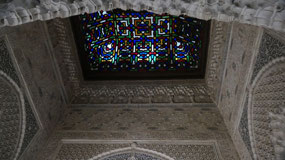
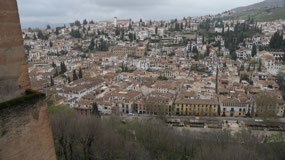
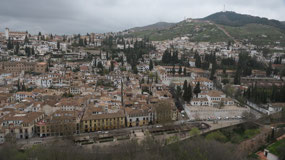
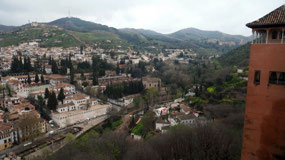
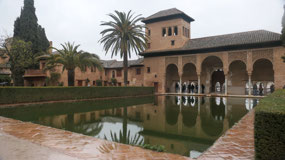
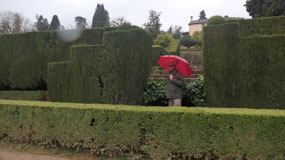
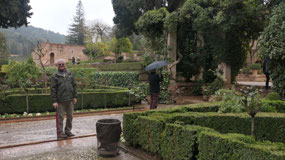
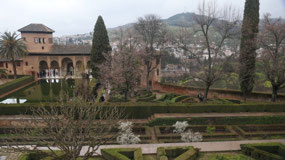
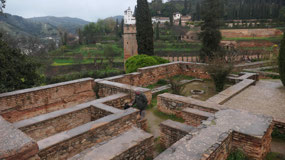
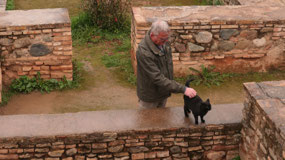
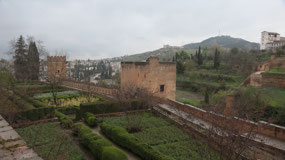
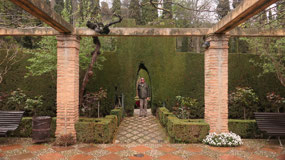
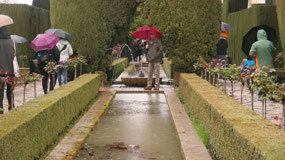
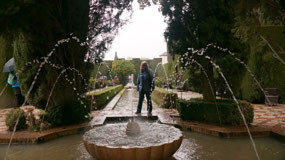
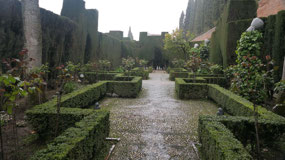
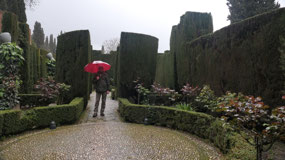
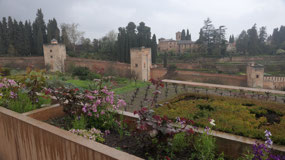
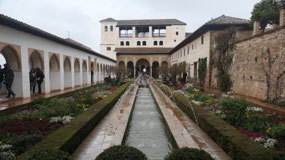

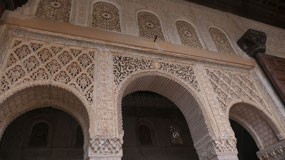
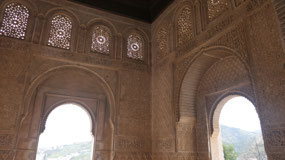
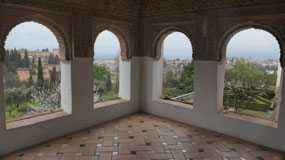
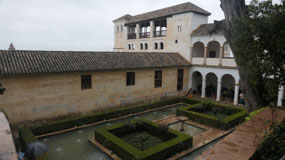

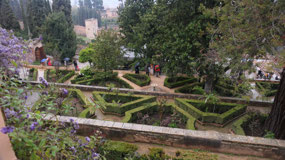
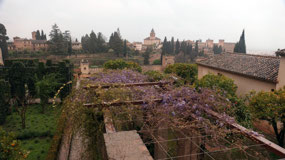
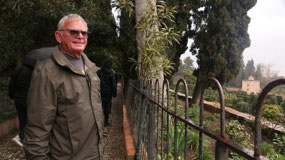
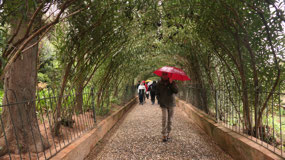
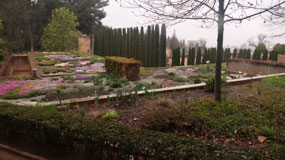
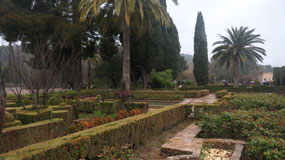

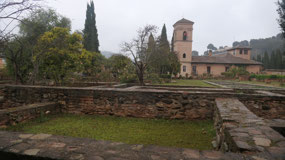
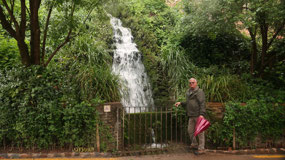
2025-05-22